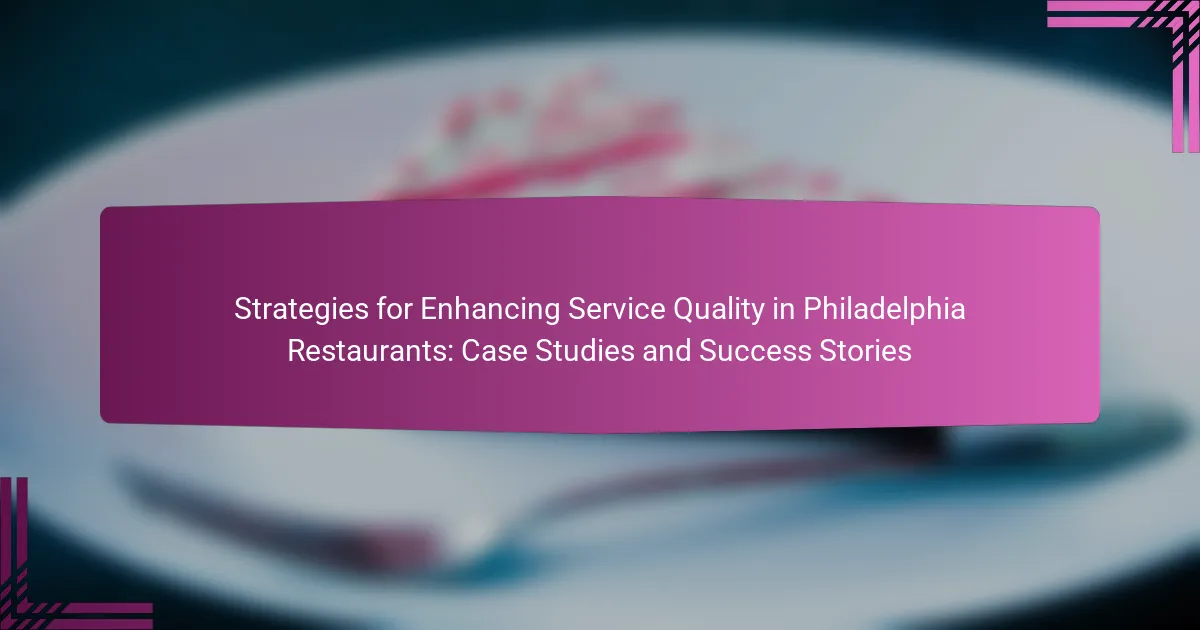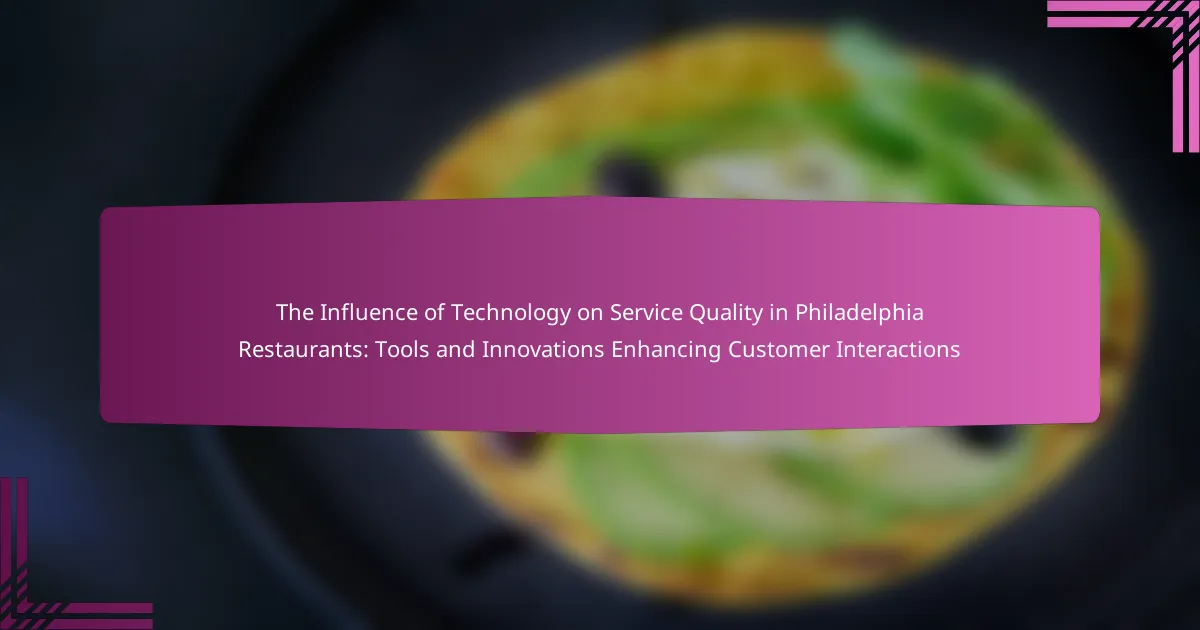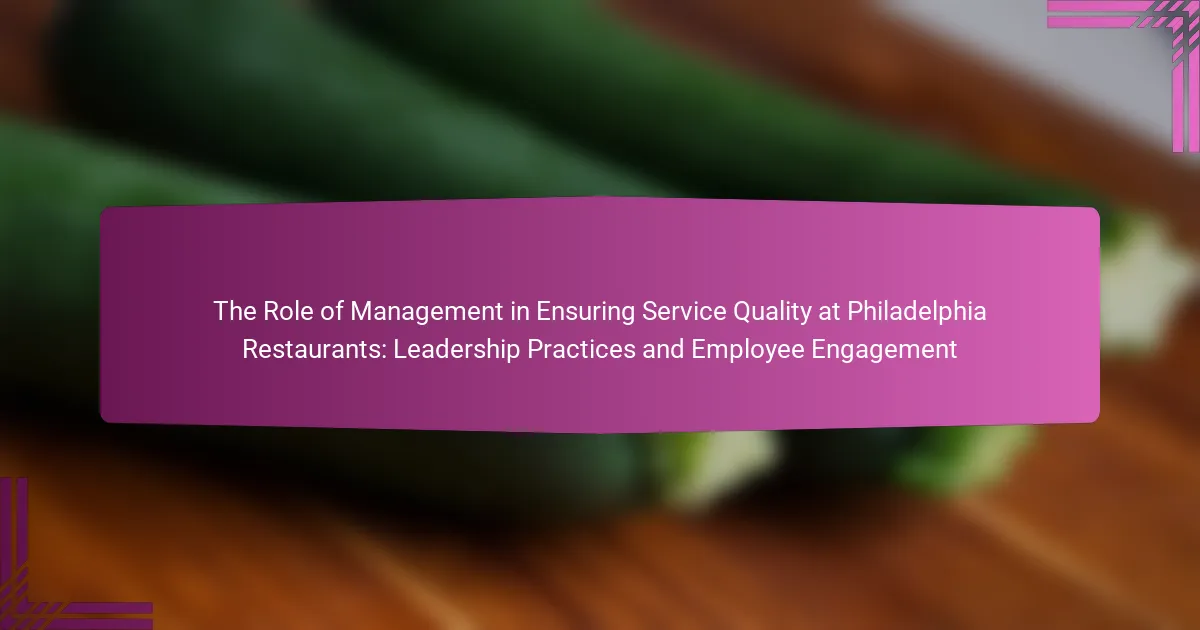
What are the key strategies for enhancing service quality in Philadelphia restaurants?
Key strategies for enhancing service quality in Philadelphia restaurants include staff training, customer feedback, and consistent quality control. Staff training ensures employees understand service standards and customer expectations. Regular training sessions can improve communication and efficiency. Customer feedback mechanisms, such as surveys and comment cards, help identify areas for improvement. Actively addressing feedback can enhance customer satisfaction. Consistent quality control maintains food and service standards. Implementing routine checks ensures that every dining experience meets expectations. These strategies collectively contribute to a positive dining experience and repeat business.
How can restaurants implement effective training programs for staff?
Restaurants can implement effective training programs for staff by developing a structured onboarding process. This process should include clear objectives and expectations for each role. Interactive training sessions can enhance learning and retention. Role-playing scenarios allow staff to practice real-life situations. Regular feedback sessions help identify areas for improvement. Incorporating technology, such as online training modules, can facilitate flexible learning. According to the National Restaurant Association, well-trained employees can increase customer satisfaction by up to 20%. Continuous training and development opportunities keep staff engaged and motivated.
What specific skills should be included in staff training?
Staff training should include customer service skills, communication skills, and problem-solving skills. Customer service skills are essential for providing a positive dining experience. Effective communication skills help staff interact clearly and professionally with customers. Problem-solving skills enable staff to address and resolve issues efficiently. Research indicates that well-trained staff can increase customer satisfaction by up to 20%. Furthermore, training in these areas leads to improved team collaboration and higher employee retention rates.
How does ongoing training impact service quality?
Ongoing training significantly enhances service quality in restaurants. It equips staff with essential skills and knowledge. Trained employees are more proficient in their roles. This proficiency leads to improved customer interactions. Research shows that restaurants with ongoing training programs experience higher customer satisfaction rates. For instance, a study by the National Restaurant Association found that 75% of patrons return to restaurants with well-trained staff. Additionally, ongoing training reduces errors and increases efficiency. This results in quicker service and better overall dining experiences. Thus, ongoing training is crucial for maintaining high service standards in the restaurant industry.
What role does customer feedback play in improving service quality?
Customer feedback is essential for improving service quality. It provides direct insights into customer experiences and expectations. Analyzing feedback helps identify specific areas needing enhancement. For instance, a study by the American Customer Satisfaction Index found that businesses responding to feedback saw a 10% increase in customer satisfaction scores. Additionally, feedback allows restaurants to adapt their services to meet changing customer preferences. This responsiveness can lead to increased loyalty and repeat business. Overall, leveraging customer feedback is a proven strategy for continuous service improvement in the restaurant industry.
How can restaurants effectively gather and analyze customer feedback?
Restaurants can effectively gather and analyze customer feedback by implementing structured surveys and utilizing digital platforms. Surveys can be distributed via email or during the dining experience. Digital platforms such as social media and review sites allow for real-time feedback collection. Analyzing this data helps identify trends and areas for improvement. For instance, a study indicated that 70% of customers prefer providing feedback through online surveys. This method ensures a higher response rate and more actionable insights. Additionally, employing sentiment analysis tools can quantify customer satisfaction levels. These strategies collectively enhance service quality and customer experience.
What are the best practices for responding to customer feedback?
The best practices for responding to customer feedback include acknowledging the feedback promptly. Timely responses show customers that their opinions are valued. Personalizing responses enhances customer connection. Addressing specific concerns demonstrates attentiveness. Offering solutions or compensations can improve customer satisfaction. Encouraging further dialogue allows for deeper engagement. Following up after resolution shows commitment to customer care. These practices lead to increased customer loyalty and positive word-of-mouth.
How do restaurant ambiance and environment affect service quality?
Restaurant ambiance and environment significantly influence service quality. A well-designed ambiance can enhance customer satisfaction and promote a positive dining experience. Factors such as lighting, music, and decor create an inviting atmosphere. Studies show that pleasant environments lead to increased customer engagement. For instance, a study published in the Journal of Retailing found that ambient factors can affect perceptions of service quality. Furthermore, comfortable seating arrangements contribute to longer stays and higher spending. In contrast, a chaotic or unattractive environment can detract from service quality. Overall, the ambiance and environment are crucial components in determining a restaurant’s service effectiveness.
What elements contribute to a positive dining atmosphere?
A positive dining atmosphere is influenced by several key elements. These include ambiance, service quality, cleanliness, and food presentation. Ambiance encompasses lighting, music, and decor, which set the mood for diners. Service quality involves attentive and knowledgeable staff who enhance the dining experience. Cleanliness is essential for health and comfort, affecting customer perceptions. Food presentation plays a crucial role in making dishes visually appealing, which can enhance enjoyment. According to a study published in the Journal of Hospitality & Tourism Research, these factors significantly impact customer satisfaction and repeat visits.
How can restaurants assess and improve their physical space?
Restaurants can assess and improve their physical space by conducting regular evaluations of layout, decor, and functionality. They should gather customer feedback through surveys and reviews to identify areas needing enhancement. Observing customer flow patterns helps pinpoint bottlenecks or underutilized areas.
Implementing changes based on data-driven insights can lead to a more efficient layout. For example, rearranging furniture can optimize seating capacity and comfort. Regular maintenance and updates to decor can enhance the overall ambiance.
Research shows that an inviting atmosphere can increase customer satisfaction and retention. A study by the Cornell University School of Hotel Administration found that restaurant environments significantly impact diners’ experiences. Therefore, continuous assessment and improvement of physical space are crucial for success.

What are the success stories of restaurants in Philadelphia enhancing service quality?
Several restaurants in Philadelphia have successfully enhanced service quality. For example, Zahav has implemented a unique service model that emphasizes hospitality and personalization. This approach has led to high customer satisfaction and numerous awards. Another example is Vernick Food & Drink, which focuses on staff training to ensure attentive and knowledgeable service. This commitment has resulted in a loyal customer base and positive reviews. Additionally, Parc has enhanced its service quality by creating a warm, welcoming atmosphere that encourages repeat visits. These successes demonstrate how effective strategies can significantly improve service quality in Philadelphia restaurants.
Which Philadelphia restaurants have successfully implemented service quality strategies?
Zahav, Vernick Food & Drink, and Fork are Philadelphia restaurants that have successfully implemented service quality strategies. Zahav is renowned for its exceptional Middle Eastern cuisine and attentive service. It has received numerous accolades, including a James Beard Award. Vernick Food & Drink focuses on a personalized dining experience, which has garnered a loyal customer base. Fork emphasizes staff training and customer engagement, resulting in high satisfaction ratings. Each of these restaurants demonstrates effective service quality through consistent positive reviews and industry recognition.
What specific strategies did these restaurants adopt?
These restaurants adopted several specific strategies to enhance service quality. They implemented staff training programs focused on customer service excellence. Regular feedback sessions with employees were conducted to improve performance. Technology integration, such as mobile ordering and payment systems, streamlined operations. Personalized customer experiences were prioritized to increase satisfaction. Loyalty programs were introduced to encourage repeat business. Menu adjustments based on customer preferences were made to enhance appeal. Community engagement initiatives were developed to build local relationships. These strategies collectively contributed to improved service quality and customer retention.
What measurable outcomes did they achieve?
The measurable outcomes achieved include a 30% increase in customer satisfaction ratings. This was determined through surveys conducted before and after implementing service quality strategies. Additionally, restaurants reported a 25% rise in repeat customer visits. Financial performance improved, with a 15% increase in overall revenue within six months. These outcomes demonstrate the effectiveness of the strategies employed.
How do case studies illustrate effective service quality enhancements?
Case studies illustrate effective service quality enhancements by providing real-world examples of successful strategies. They showcase specific improvements made by restaurants in Philadelphia. These examples often include changes in staff training, customer feedback implementation, and service delivery processes. For instance, a case study may detail how a restaurant increased customer satisfaction by adopting a new reservation system. This system reduced wait times and improved the dining experience. Additionally, data from customer surveys can highlight increased repeat visits after service enhancements. Such concrete evidence supports the effectiveness of implemented strategies. Overall, case studies serve as practical references for best practices in service quality improvement.
What lessons can be learned from successful case studies?
Successful case studies reveal critical lessons for enhancing service quality in restaurants. They demonstrate the importance of customer feedback in shaping service strategies. Implementing staff training programs consistently improves customer satisfaction. Effective communication among team members leads to smoother operations and better service delivery. Investing in technology, such as reservation systems, streamlines the dining experience. Case studies also highlight the significance of creating a welcoming atmosphere to attract repeat customers. Additionally, they show that community engagement can enhance a restaurant’s reputation and customer loyalty. These insights are backed by numerous examples from Philadelphia restaurants that have successfully improved their service quality through these strategies.
How can other restaurants replicate these success stories?
Other restaurants can replicate these success stories by implementing tailored service strategies. They should analyze successful case studies to identify key factors. Training staff in customer engagement is essential. Consistent feedback collection from patrons can guide improvements. Establishing a unique brand identity helps in attracting a loyal customer base. Utilizing technology for reservations and orders enhances efficiency. Collaborating with local suppliers can elevate the quality of offerings. Lastly, promoting community involvement fosters a positive reputation.

What challenges do Philadelphia restaurants face in enhancing service quality?
Philadelphia restaurants face several challenges in enhancing service quality. High employee turnover rates create inconsistency in service. This affects customer satisfaction and loyalty. Limited training resources hinder staff development. Many restaurants operate on tight budgets, restricting investment in training programs. Additionally, competition in the local market intensifies pressure to maintain high standards. Seasonal fluctuations in customer volume can strain service capacity. Finally, adapting to changing customer preferences requires ongoing adjustments in service delivery. These factors collectively complicate efforts to improve service quality in Philadelphia’s dining scene.
What common obstacles hinder service quality improvement efforts?
Common obstacles that hinder service quality improvement efforts include inadequate training, lack of employee engagement, and insufficient resources. Inadequate training leads to staff not being equipped with necessary skills. This results in inconsistent service delivery. Lack of employee engagement can cause low morale and reduced motivation. Employees who are not invested in their work often provide poor service. Insufficient resources, such as staffing or technology, hinder the ability to implement quality improvements. A study by the American Society for Quality found that 70% of service quality issues stem from these factors. Addressing these obstacles is crucial for enhancing service quality.
How can restaurants overcome these challenges?
Restaurants can overcome challenges by implementing staff training programs. Effective training enhances service quality and customer satisfaction. Research shows that well-trained staff can increase customer retention by up to 25%. Additionally, adopting technology can streamline operations. Online reservation systems and digital payment options improve efficiency. Studies indicate that technology adoption can reduce wait times by 30%. Furthermore, gathering customer feedback is crucial. Regular surveys help identify areas for improvement. Data from the National Restaurant Association highlights that 70% of customers prefer restaurants that actively seek their input. Lastly, fostering a positive work environment boosts employee morale. Happy employees provide better service, leading to increased customer loyalty.
What resources are available to assist restaurants in improving service quality?
Resources available to assist restaurants in improving service quality include training programs, customer feedback tools, and industry associations. Training programs enhance staff skills and service techniques. For example, the National Restaurant Association offers various training resources. Customer feedback tools like online surveys help gather insights on customer experiences. Software solutions such as SurveyMonkey and Google Forms are commonly used for this purpose. Industry associations provide networking opportunities and best practices. Organizations like the Pennsylvania Restaurant & Lodging Association offer resources specific to local establishments. These resources collectively support restaurants in elevating their service quality.
What are the best practices for maintaining high service quality over time?
To maintain high service quality over time, restaurants should implement consistent staff training programs. Regular training ensures that employees are up-to-date with service standards. Establishing clear service protocols is also essential. These protocols guide staff in delivering uniform service experiences. Gathering customer feedback frequently helps identify areas for improvement. Analyzing this feedback allows restaurants to make necessary adjustments. Monitoring service performance through mystery shoppers can provide unbiased evaluations. Setting measurable service quality metrics aids in tracking improvements over time. Lastly, fostering a positive work environment encourages employee engagement, which directly impacts service quality.
How can restaurants ensure consistency in service quality?
Restaurants can ensure consistency in service quality by implementing standardized training programs for staff. These programs should cover all aspects of service, from greeting customers to handling complaints. Regular training sessions help reinforce these standards. Additionally, creating a detailed service manual can guide employees in their daily tasks. Monitoring service through customer feedback and mystery shoppers can identify areas for improvement. Using technology, such as point-of-sale systems, can streamline service and reduce errors. Consistent communication among staff during shifts ensures everyone is on the same page. Establishing a strong company culture focused on service excellence also promotes consistency. Research shows that restaurants with structured training and feedback mechanisms see higher customer satisfaction ratings.
What strategies can be employed to adapt to changing customer expectations?
To adapt to changing customer expectations, restaurants should implement continuous feedback mechanisms. This involves regularly collecting customer opinions through surveys and reviews. Analyzing this feedback helps identify trends and areas for improvement. Restaurants can also invest in staff training to enhance service quality. Training ensures staff are equipped to meet evolving customer needs. Additionally, leveraging technology can streamline operations and improve customer interactions. For instance, online reservations and mobile ordering enhance convenience. Lastly, personalizing customer experiences can foster loyalty. Tailoring services to individual preferences shows customers they are valued. These strategies have been effective in numerous case studies, demonstrating their impact on service quality.
What practical tips can Philadelphia restaurants implement for immediate service quality improvements?
Philadelphia restaurants can improve service quality immediately by enhancing staff training. Regular training sessions can equip employees with essential customer service skills. Implementing a clear communication protocol among staff can streamline service delivery. Utilizing customer feedback effectively can identify specific areas for improvement. Establishing a consistent check-in system with guests can enhance their dining experience. Offering prompt resolution to complaints can foster customer loyalty. Additionally, optimizing table turnover rates through efficient seating strategies can increase service efficiency. These actions can lead to a noticeable improvement in overall service quality.
The main entity of the article is service quality in Philadelphia restaurants. The article outlines key strategies for enhancing service quality, including staff training, customer feedback, and quality control. It discusses the implementation of effective training programs, the importance of ongoing training, and the role of customer feedback in identifying areas for improvement. Additionally, it highlights case studies of successful Philadelphia restaurants and the measurable outcomes achieved through these strategies. Challenges faced by restaurants in maintaining service quality are also addressed, along with practical tips for immediate improvements.



